For years, travel has been about ticking boxes, visiting as many landmarks as possible, snapping quick photos, and rushing to the next stop. But in 2025, a new wave of travelers is choosing something different: slow travel. It’s less about racing through itineraries and more about immersing yourself in one place, living like a local, and embracing the calm that comes with unhurried exploration.
What is Slow Travel?
Slow travel is a mindset, not just a method. Instead of cramming five cities into a week, you choose one destination and spend days or even weeks discovering its rhythm. You explore neighborhoods, talk to locals, try seasonal food, and enjoy mornings without alarm clocks.
It’s about valuing quality over quantity, depth over distance.

Why Slow Travel is Rising in 2025
1. People Want More Meaning
After years of fast-paced living, travelers crave more than postcard moments. They want to connect with places, understand cultures, and return home with stories rather than checklists.
2. Sustainability Matters
Frequent flights and constant movement leave a heavy footprint. Staying longer in one place reduces transportation emissions, supports local businesses, and helps preserve destinations.
3. Remote Work + Flexible Lifestyles
With remote work becoming normal, many travelers are combining work and leisure. A month in a quiet town or coastal village is not just vacation. it’s a lifestyle.
4. Mental Health and Calm
Slow travel aligns with the desire for calm living. Less rushing means lower stress, better sleep, and more presence in the moment. Travelers are realizing that rushing often leaves them more exhausted than before they left.
The Benefits of Slow Travel
🧘 Less Stress, More Presence
You’re not running to catch trains or squeezing in tours. You can wake up when your body tells you to, wander slowly, and savor experiences.
🌱 Deeper Cultural Connection
Instead of just seeing tourist attractions, you live daily life: shop at local markets, learn phrases in the language, and maybe even make friends.
🏞️ Time to Notice Details
When you’re not rushing, you notice the colors of doorways, the sound of birds in the morning, or the quiet charm of a street café. These small details often become your favorite memories.
💸 Better for Your Budget
Staying longer often means cheaper stays (weekly/monthly rates), fewer transport costs, and the ability to cook or shop locally instead of eating out for every meal.
🌍 Supports Local Communities
Slow travel isn’t just better for you, it’s better for the places you visit. You’re giving more to the local economy and taking less from the environment.
How to Practice Slow Travel
-
Choose fewer destinations. Instead of three countries in 10 days, pick one region for 10 days.
-
Stay longer. Book one Airbnb or guesthouse for a week rather than moving every night.
-
Walk or cycle. Explore at human pace. You’ll see more than from a tour bus.
-
Eat local. Visit small cafés, family-owned restaurants, and local markets.
-
Learn a little language. Even a few words create connection.
-
Be flexible. Don’t schedule every hour. Leave space for spontaneous moments.

Destinations Perfect for Slow Travel
Kyoto, Japan: Tea ceremonies, Zen gardens, traditional streets, best experienced slowly.
Lisbon, Portugal: Old trams, pastel tiles, and ocean breezes at a slower rhythm.
Iceland’s Countryside: Hot springs, waterfalls, and wide open spaces for quiet reflection.
Chiang Mai, Thailand: Calm temples, night markets, and a hub for slow digital nomads.
Conclusion: Slowing Down to See More
-
-
Slow travel isn’t about doing less, it’s about experiencing more deeply. In 2025, when life feels faster than ever, choosing to travel slowly is an act of balance. By staying longer, moving less, and connecting more, you return not just with photos but with calm, memories, and meaning.
Because sometimes, the best way to see the world is not to rush through it, but to sit still and let it reveal itself.
-










